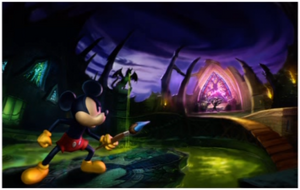Epic Mickey is a hybrid of a platformer, action-adventure and RPG developed by Junction Point Studios and published by Disney Interactive Studios about Mickey Mouse and the history of Disney. It was released on November 30th, 2010 in the United States, November 26th, 2010 in Europe and September 28, 2012 in Australia and a localized version with camera issues fixed and the difficulty setting tweaked was released on August 4th in Japan by Nintendo. The Japanese version also has its name changed into Disney Epic Mickey: Mickey Mouse and the Magic Brush. 1.As of July 2014, the game has sold nearly 3 million copies worldwide.2 It was followed by a sequel, Epic Mickey 2: The Power of Two and a spin-off, Epic Mickey: Power of Illusion.
Production
The video game was designed by Warren Spector at Junction Point,while being published by Disney Interactive Studios.
Early Production
The initial plans were developed in a think-tank session in 2006 about how best to renew Mickey Mouse in the eyes of the public. The Wasteland concept and Oswald and the Phantom Blot as antagonists were part of this initial pitch and the project became a factor in Disney getting Oswald back from Universal that year. They signed Warren Spector, who was skeptical that Disney would just continue watering down Mickey as they had for many years, but was convinced when told he would be allowed to help renew the character. Given full-access to the archives for inspiration on the Wasteland's setting, Warren Spector developed the game further into a hybrid platformer/roleplaying game with player's choices being a huge influence in how the story would turn out. The game was originally being developed as a steam-punk styled title. The game was going to be produced for the Xbox 360 and PS3 in 2008. In 2008, Gamasutra published a report claiming to have seen concept art for the game. These concept art images were leaked unto the internet and created a buzz as to whether or not the game was real. Concept art for the game by Fred Gambino and Gary Glover depicts a "surrealistically bizarre" look at Disney characters and locations. Featured in the concept art are post-apocalyptic renditions of Goofy, Spaceship Earth, and Cinderella's Castle.
Early Concept Art
However, when talks a of a Wii port began, Disney Interactive suggested that a Mickey Mouse title would work for the Wii.
Late 2009 and Early 2010
The game had change dramatically from screenshots and art being presented to the public. It had gone from the post-apocalyptic steam punk styled wasteland to a new more gloomy chaotic shapeless abyss.
Mid 2011
It is revealed that a sequel may be in development. It was later confirmed in January 2012.
September 2011
Warren Spector announced Epic Mickey 3 as a project that he would like to do, but nothing is confirmed at this point.
January 2013
Junction Point announced that it was closing, making any chances of Epic Mickey 3 being produced very slim.
May 2016
Disney Interactive Studios, the publisher of the Epic Mickey games was closed as Disney is leaving the console game-publishing business, making the chances of another Epic Mickey game being produced near impossible.
Story
A long time ago, the sorcerer Yen Sid used a magic paintbrush to create a world for Disney's forgotten characters (from creations to rusted Disney attraction parts). This was held in an intricate model on a table and was accessible through a mirror. One day Mickey is taking a nap, when his mirror makes an odd noise, awakening him. He climbs onto his dresser and pokes it, to see that he can go through it. Mickey, who finds himself inside Yen Sid's study, sees the model and waits until Yen Sid is gone before going back to take another look at it. Fiddling with it, Mickey attempts to create a statue of himself in the world but instead creates the Shadow Blot. He attempts to erase it, and ends up spilling paint on the model. He attempts to clean it up in a haste, but just spills even more paint and thinner, twisting the world. He managed to escape without Yen Sid knowing, returning to his world where he went on to live years of success and fame, but his meddling had consequences.
The paint and paint thinner have severely damaged the world and created an evil being called the "Shadow Blot", who has usurped power from Oswald the Lucky Rabbit, Disney's first creation before Mickey, and sent the world into ruin. A long time later, Mickey is kidnapped by the fake Fake Shadow Blot and sent into the world. Oswald is shocked to see him and flees the scene.
The Mad Doctor worked closely with Oswald (at first) then the Blot, creating robotic "Beetleworx", which once helped out but now patrol the wasteland, capturing Gremlins, robot versions of Mickey's friends called "buddies" for Oswald, looking like Donald Duck, Goofy and Daisy Duck as Oswald misses popularity. When he escaped, he found out what he had done. To help clean up his mess, he pulled in the paintbrush he got kidnapped. So now, Mickey must stop the Shadow Blot, gain the trust of Oswald and save the forgotten world.
Features

In Epic Mickey, the character can control Mickey's path in Wasteland. The game features the brush mechanism, where the player can aim with the Wii remote to either paint things in, or make them disappear thinner. The player's decisions can change parts of the game, such as other characters' opinions on Mickey, and more subtle changes such as slower music or the blot drops coming off of Mickey.
His was appearance was originally supposed to change more drastically based on his actions. However, the mechanism was scrapped in favor of the Guardian system. It is suspected that this may have been removed due to Disney's input. See the Trivia section.
Reception
Epic Mickey enjoyed high pre-release awareness and received mostly positive reviews, with a score of 72.57% on GameRankings and 73/100 on Metacritic.
IGN gave it a score of 8/10, criticizing its camera, control issues and lack of voice acting, but praised its charm, story, art design, and lasting appeal for the players. Video game talk show Good Game's two presenters gave the game a 6 and 7 out of 10. They compared the paintbrush abilities to that of the water jet pack from Super Mario Sunshine and found it frustrating how the levels reset back to their original state after leaving. But on a positive note they said it "isn't as 'dark' or 'adult' as the hype made it out to be... I guess it is a kid's game after all, but at least it's an intelligent one. It doesn't come anywhere near the complexity and fun of something like Super Mario Sunshine, which I think it borrows some ideas from." Shirley Chase from GameZone complimented the game on its usage of Disney history, but added that the game had numerous flaws saying, "For all of its good points, Disney Epic Mickey does have some glaring flaws, which can make the game feel like a chore. The most noticeable problem is the camera, which will lead to more cheap deaths than anything else." In a review for GamesRadar, Chris Antista who began the article as an admitted "diehard Disney dork", praised it as a "thoroughly heartwarming salute to Disney" and that he hasn't "fallen so head over heels with the look, feel, and play of a third-person platformer since the original Banjo-Kazooie".
In its opening weekend, Epic Mickey failed to reach the UK Top 40 and even the Wii Top 10 sales charts after its November 26 UK release. On November 30, 2010, the release date in North America, the game was completely sold out on the Disney Store website by the afternoon. The game sold 1.3 million copies its first month. As of July 2014, the game sold nearly 3 million copies in North America and Europe combined.
Trivia
- Epic Mickey can be compared to games like Shadow the Hedgehog, inFAMOUS, and Spider Man: Web of Shadows, because they are darker representations of the game's franchise (this only applies to Shadow the Hedgehog & Spider Man: Web of Shadows) and their stories depend on the player's choices.
- In the UK, GAME stores offered a t-shirt as a pre-order bonus. The t-shirt, however, was just regular/current Mickey, with no actual connection to the Epic Mickey game.
- A Dutch release of the game also came packaged with a copy of Fantasia on DVD.
- According to Warren Spector, the game was thought of before his company was bought by Disney, which means that Epic Mickey was technically in development for almost 10 years.
- Warren Spector wanted to make a movie of Epic Mickey. He even had a trailer, budget and a team lined up, but Disney was uninterested. [1]
- In an interview with Chad Moldenhaur (studio art director of Studio MDHR/co-creator of Cuphead) about the game Cuphead, Warren Spector mentions that he wanted to use an "early-30's" look for Epic Mickey. [1]
- Screenshots of an early version of the game suggest the game was originally going to use a lives system.
- According to Warren Spector, Disney may have been the cause of the removal of the "Hero Mickey" and "Scrapper Mickey" gameplay mechanic. In an interview, he stated that Disney gave the development team a lot of creative freedom, but was a bit more touchy with how they handled Mickey Mouse. He stated that Disney had a bit of a hard time swallowing the idea of Mickey's appearance changing depending on the player's actions. Perhaps they were worried that it would ruin Mickey's image if the player made bad choices.
Gallery
For more pictures and screenshots of Epic Mickey, click here
